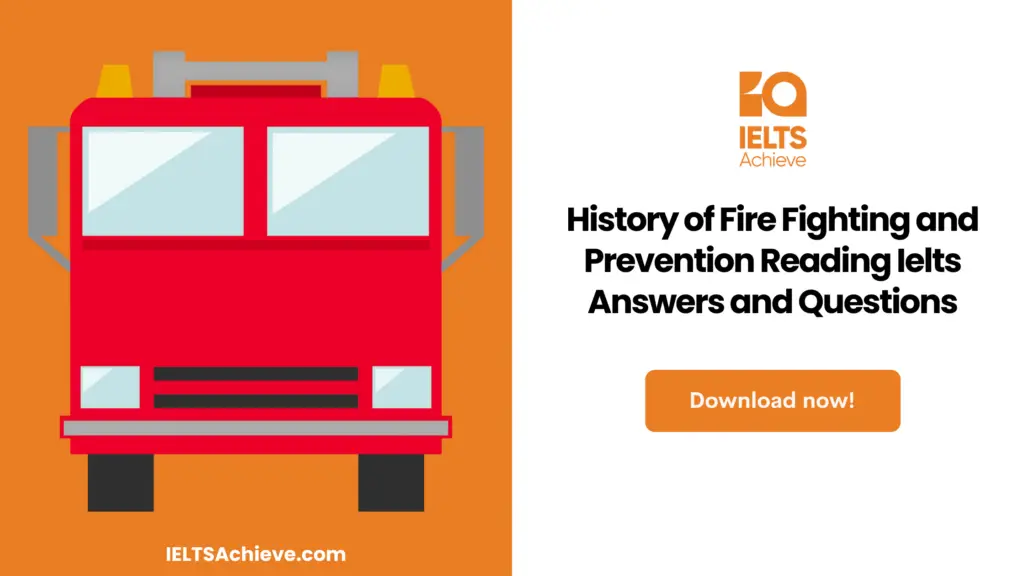The Blog post contains the following IELTS Reading Questions:
- IELTS reading note completion
- IELTS reading true/false/not given
- IELTS reading locating information
Stay informed and prepared for success – Explore our comprehensive Reading Test Info page to get valuable insights, exam format details, and expert tips for mastering the IELTS Reading section.
IELTS reading passage – History of Fire Fighting and Prevention

History of Fire Fighting and Prevention
- More than 2000 years ago, a Roman emperor named Augustus organised a group of watchmen whose job was mainly to look out for fires and sound an alarm in the event of one. For many centuries that followed, fire fighting was done using buckets of water that got passed from person to person. The axe was then found to be a useful tool both for removing fuel in large fires and for opening holes to allow smoke and flames to get away from burning buildings. Watchmen created fire breakers with long rods hooked with ropes to pull structures down that provided fuel for a flame. To reduce the risk of flame in thatched-roof houses, King William the Conqueror in 1066 made a ruling: people had to put out their cooking flames at night. His term couvre-feu, which means “cover flame,” is the origin of the modern-day term curfew, which no longer carries a literal translation.
- The event that had the largest influence in the history of fire fighting was in 1666 called the Great flame of London. The devastating incident occurred at the King’s Bakery near the London Bridge. At the beginning, Lord Mayor Bludworth showed little concern for the flame, thinking it would extinguish itself. Later he organised a group of men to put out the fire. In 1666. the summer was exceptionally hot and dry, and the houses made of straws and wood caught flame quickly. Within a short span of time, the wind had carried the flame across the city, burning down over three hundred houses in its path. Although the procedure of pulling down buildings to prevent a flame from spreading was standard in Britain, the mayor became worried over the expenses it would incur to rebuild the city and ordered that the surrounding structures be left undamaged. By the time the king ordered the destruction of buildings in the flame’s path, the flame was out of control. The Duke of York ordered the Paper House to be destroyed in order to create a crucial flame break and the London flame finally began to lose its fuel.
- Extreme measures were taken in London to create a system of organised flame prevention when it became clear that four-fifths of the city had been destroyed by the flame. Most of London was reconstructed using stone and brick and materials that were far less flammable than wood and straw by architect Christopher Wren. Those who could afford to build new homes and businesses began to seek insurance for their properties because of the long history of fires in London. Companies soon realised the monetary benefits of hiring men to extinguish flames as insurance became a profitable business. In the initial years of insurance companies, the insurance company marked all insured properties with its name or logo. If a fire broke out and a building did not have an insurance mark, the fire brigades were called away and the building was left to burn.
- The British insurance companies were largely responsible for occupying people to create new technologies for firefighting. The first flame engines were simple containers on wheels that were pulled towards the location of the flame, with water being supplied by a bucket brigade. A hand pump was created to push the water out of the container through a hose with a nozzle. The pump was used to allow a steady stream of water to shoot through the hose directly at the source of fire. Before long, companies began to make use of water pipes made from hollowed tree trunks that were built under the roads. By digging down into the road, firefighters could make a hole into the tree-trunk pipe and connect it to the water to feed into the pump.
- As companies fought to be the first to arrive at a scene to access the water pipes, fire fighting became a very competitive business. Firefighting companies were forced to reconsider their intentions, after a series of fires destroyed some areas of London. By the 18th century, firefighters began to join forces, and in 1833 the Sun Insurance Company along with ten other London companies established the London Fire Engine Establishment. In 1865, the government involved and brought new standards to both prevent and fight fire by establishing London’s Metropolitan Fire Brigade. The firemen were paid good salary, but they had to be on duty constantly and thus calledl their fire station home for both themselves and their families.
- Both Europe and the New World continued to create new firefighting technology. In the Netherlands, leather hoses with couplings that connected the lengths were hand-sewn and utilised until the late 1800s, when rubber hoses became available. In 1829, steam engine fire vehicles were available in the United Kingdom and America, but most fire departments were reticent to deploy them until the 1850s. The public was ultimately responsible for forcing the fire departments to employ more efficient equipment. When the internal-combustion engine was invented in the early 1900s, trucks became motorised. This was an important development in firefighting history, as World War I imposed additional strain on fire departments around the world.
Unlock your full potential in the IELTS Reading section – Visit our IELTS Reading Practice Question Answer page now!
Recommended Questions:
Renewable Energy IELTS Reading Question with Answer
History of Fire Fighting and Prevention IELTS reading questions
Questions 1- 5
Complete the notes below. Write NO MORE THAN TWO WORDS AND/ OR A NUMBER from the passage for each answer.
- History of firefighting datesback to more than ________ years.
- The major incident that influenced the history of firefighting occured in ________.
- London was reconstructed by an architect named ________.
- The ________ companies were largely responsible for engaging people to make firefighting technologies.
- The London Fire Engine Establishment was created in the year ________.
Boost your performance in Summary, Notes, Table, and Flowchart Completion tasks. Click here to explore our detailed guide and learn how to effectively complete summaries, notes, tables, and flowcharts in the IELTS Reading section.
Questions 6-10
Do the following statements agree with the information given in the reading passage?
Write
- TRUE if the statement agrees with the information
- FALSE if the statement contradicts the information
- NOT GIVEN if there is no information on this in the passage
6. Initially, fire fighting was done using buckets of water that got passed from person to person.
7. The fire accident occurred at the King’s Bakery near the London Bridge in 1666.
8. Buildings in London were reconstructed using wood and straw.
9. The first flame engines were simple containers on wheels.
10. In 1829, steam engine fire vehicles were available in the UK and America.
Enhance your skills in identifying information as True, False, or Not Given. Click here to discover expert strategies and techniques for mastering this question type in the IELTS Reading section.
Questions 11-15
This reading passage has six paragraphs, A–F. Which paragraph contains the following information? Write the correct letter, A-F, as your answer to each question. Note: You may use any letter more than once.
11. Watchmen created fire breakers with long rods hooked with ropes to pull structures down that provided fuel for a flame.
12. The Duke of York ordered the Paper House to be destroyed in order to create a crucial flame break and the London flame finally began to lose its fuel.
13. Extreme measures were taken in London to create a system of organised flame prevention when it became clear that four-fifths of the city had been destroyed by the flame.
14. Companies began to make use of water pipes made from hollowed tree trunks that were built under the roads.
15. The firemen were paid a good salary, but they had to be on duty constantly and thus called their fire station home for both themselves and their families.
Unlock your full potential in the IELTS Reading section – Visit our IELTS Reading Practice Question Answer page now!
Recommended Questions:
Renewable Energy IELTS Reading Question with Answer
History of Fire Fighting and Prevention IELTS reading answers
1 2000
2 London
3 Christopher Wren
4 British insurance
5 1833
6 True
7 True
8 False
9 True
10 True
11 Paragraph A
12 Paragraph B
13 Paragraph C
14 Paragraph D
15 Paragraph E

We hope you found this post useful in helping you to study for the IELTS Test. If you have any questions please let us know in the comments below or on the Facebook page.
The best way to keep up to date with posts like this is to like us on Facebook, then follow us on Instagram and Pinterest. If you need help preparing for the IELTS Test, join the IELTS Achieve Academy and see how we can assist you to achieve your desired band score. We offer an essay correction service, mock exams and online courses.

